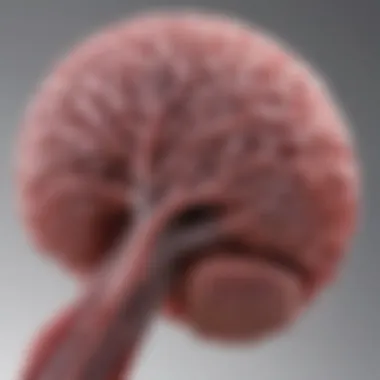Cerebral Amyloid Angiopathy and Stroke Risk Factors


Intro
Cerebral amyloid angiopathy presents a fascinating yet intricate issue within the realm of cerebrovascular health. At its core, CAA involves the deposition of amyloid beta peptides in the wall of the cerebral blood vessels, ultimately impacting their integrity and functioning. Many people, including professionals and students, often overlook how this condition can significantly elevate the risk of stroke. As we delve into this exploration, our path will cover not only the biological mechanisms at play but also the diagnostic challenges and potential therapeutic strategies that are emerging from recent research.
Our journey will unravel the delicate interplay between amyloid deposits and vascular integrity, thereby shedding light on the implications for stroke risk. Understanding the nuances of this relationship will foster a deeper comprehension of not only CAA itself but also the broader implications within cerebrovascular disorders.
Key Concepts and Terminology
Definition of Key Terms
- Cerebral Amyloid Angiopathy (CAA): A condition characterized by amyloid beta accumulation in cerebral vessels, leading to potential vascular dysfunction.
- Stroke: A medical emergency that occurs when the blood supply to the brain is disrupted, resulting in cell death.
- Neuropathy: Refers to disorders that occur due to the dysfunction of one or more peripheral nerves, often causing weakness, numbness, and pain, usually in the hands and feet.
Concepts Explored in the Article
- Pathophysiology of CAA: This includes understanding how amyloid deposits compromise the blood-brain barrier, altering the brain’s ability to maintain its environment.
- Clinical Implications: We'll focus on how CAA modifies stroke risk and influences patient outcomes following cerebrovascular events.
- Diagnosis: Analyzing current methods to differentiate CAA from other cerebrovascular disorders will be essential.
- Research Directions: Pinpointing avenues for future studies that could unveil novel treatment protocols for CAA-related health issues.
Findings and Discussion
Main Findings
A growing body of literature indicates a robust association between CAA and an increased likelihood of both hemorrhagic and ischemic strokes. This finding emphasizes the necessity of understanding patient histories better, particularly in older adults, who often demonstrate prevalent amyloid deposition. Key points highlighted include:
- The advanced imaging techniques, such as MRI, enhance our ability to diagnose CAA-related conditions earlier.
- Patient management strategies can be adjusted based on CAA status.
Potential Areas for Future Research
In light of the discussions surrounding cerebral amyloid angiopathy, it remains crucial to consider future research directions.
- Studies investigating the effectiveness of amyloid-targeted therapies in reducing stroke incidence could be groundbreaking.
- Further exploration of the genetic factors contributing to the susceptibility of CAA might provide further insight into prevention methods for high-risk populations.
Understanding the complex relationship between CAA and stroke isn't just an academic exercise—it's a necessary step towards improving patient outcomes.
To conclude, as we dive deeper into the nuances of cerebral amyloid angiopathy and its association with stroke, we aim to not only reveal the underlying mechanisms but also contribute substantial knowledge towards enhancing prevention and treatment strategies.
Prologue to Cerebral Amyloid Angiopathy
Cerebral amyloid angiopathy (CAA) is a vascular condition characterized by the abnormal deposition of amyloid protein within the walls of the brain's blood vessels. Understanding CAA is crucial for multiple reasons, especially since its implications extend beyond vascular health into the realm of cerebrovascular diseases such as stroke. This article aims to dissect various facets of CAA to illuminate its role in stroke pathology.
Definition and Overview
Cerebral amyloid angiopathy primarily involves the accumulation of amyloid-beta peptides in the meningeal and cortical blood vessels of the brain. Left unchecked, this abnormal protein gathering alters the structural integrity of blood vessels, potentially leading to detrimental outcomes. The severity of CAA can vary widely among individuals, affecting not only the brain's vascular structure but also its function. For example, reduced blood flow due to vessel narrowing can result in ischemic events, whereas vessel rupture may lead to hemorrhagic strokes.
It's not just a clinical definition; it paints a picture of the silent havoc wreaked on the brain's vascular network, often without prior warning signs. Recognition of this condition is essential for timely intervention and management. In summation, CAA’s definition encapsulates a disorder that intricately links amyloid deposition to severe cerebrovascular issues.
Historical Context
The journey to understanding CAA spans several decades. The term itself gained traction in the late 20th century, but hindsight reveals researchers had been observing its effects long before. Early studies hinted at the relationship between amyloid and cerebrovascular damage, although it took time to connect all the dots. Historical milestones such as the discovery of amyloid in Alzheimer’s disease provided a foundation for exploring its impact on vascular health.
Several pivotal studies in the 1980s and 1990s established a direct correlation between CAA and an increased risk of stroke, shaping current medical perspectives. In 1993, an important publication showed the impact of CAA in both cognitive decline and hemorrhagic strokes, thus broadening the research horizon. Understanding the historical context allows us to appreciate the evolution of knowledge surrounding this condition and underscores the complexities inherent in contemporary research.
Significance in Stroke Research


The significance of CAA in stroke research cannot be overstated. As stroke remains a leading cause of death and disability globally, exploring its underlying mechanisms has become pivotal. Cerebral amyloid angiopathy plays a dual role: not only does it link to traditional stroke risk factors, but it also offers a unique angle for studying idiopathic strokes.
Research has shown that CAA may serve as a gateway to understanding broader cerebrovascular disease mechanisms. For instance, the identification of specific risk factors related to CAA can enable better risk stratification for stroke patients. A finer understanding of how amyloid deposition contributes to both ischemic and hemorrhagic strokes can potentially yield new therapeutic strategies aimed at prevention.
"Cerebral amyloid angiopathy is a silent but potent player in stroke pathology, often overlooked, yet central to the conversation about cerebrovascular diseases."
Pathophysiology of Cerebral Amyloid Angiopathy
Understanding the pathophysiology of cerebral amyloid angiopathy (CAA) forms a crucial part of examining its connection to stroke. CAA itself is characterized by the accumulation of beta-amyloid peptides within the walls of cortical and leptomeningeal blood vessels, which can lead to significant changes in vascular health. As this accumulation disrupts normal blood flow and strengthens the risk of hemorrhages, knowing how these processes unfold is essential to fully grasp the implications for stroke.
Mechanisms of Amyloid Deposition
Amyloid deposition begins with the production and misfolding of amyloid precursor proteins (APP). While it’s common to think of amyloid plaques in the context of Alzheimer’s disease, here it’s the blood vessels that bear the brunt. In CAA, these deposits aren’t just stagnant; they can instigate a continuous cycle of inflammation and vascular dysfunction. What happens is, the overabundance of amyloid builds up in the vessel walls, causing them to thicken and become rigid. This rigidity compromises the elasticity of the vessels, limiting their ability to respond to blood flow and pressure changes. In simpler terms, when those blood vessels can’t flex and bend when needed, there’s a higher chance of rupture, especially during peak arterial pressure. Moreover, the exact mechanics are still being researched, but factors like genetic predisposition might also play a pivotal role in this deposition process.
Effects on Vascular Structures
When amyloid accumulates, it doesn’t just stay as harmless gum on the sidewalk. It creates a procession of subsequent damage to vascular structures. The endothelial cells, which form the inner lining of blood vessels, can become impaired by the ongoing deposition. This impairment often leads to a cascade of events, including the loss of vascular integrity, reduced blood flow, and, in some cases, complete vessel occlusion. Not to mention, exposure to amyloid may induce smooth muscle cell dysfunction, which is critical for maintaining vascular tone. Consequently, these structural alterations pave the way for hemorrhagic strokes, where weakened blood vessels burst rather than compacting against the pressure of blood flow.
Role of Blood-Brain Barrier Dysfunction
The blood-brain barrier (BBB) serves as a sentinel, that delicately regulates what enters the brain from the bloodstream. In CAA, amyloid deposits disrupt this barrier, leading to permeability issues. Increased permeability can let unwanted substances seep into the brain matter, causing an inflammatory response that thwarts proper neuronal function. This state of dysfunction can exacerbate the vascular complications brought on by CAA. In essence, when the BBB falters, the risk of both ischemic and hemorrhagic strokes amplifies, marking a dangerous intersection of CAA and cerebrovascular incidents.
“Understanding the intricacies of amyloid pathology will assist both in prevention and intervention strategies.”
Evaluating these factors presents an interconnected picture of the challenges posed by CAA in stroke risk. The interplay between amyloid deposition, vascular changes, and compromised BBB illustrates why further research is critical to develop more effective management strategies and potentially reduce the impact of stroke in affected individuals.
Cerebral Amyloid Angiopathy and Stroke Risk
Understanding the intersection between cerebral amyloid angiopathy (CAA) and stroke risk is paramount in today's medical landscape. CAA, characterized by amyloid protein deposits in the brain's blood vessels, plays a significant role in cerebrovascular health. This section lays out the intricate connections that highlight how CAA is not just a side note but a pivotal player in the stroke narrative. Recognizing these links can help in developing preventative strategies and targeted treatments.
Association Between CAA and Hemorrhagic Stroke
Hemorrhagic stroke, which results from bleeding in or around the brain, is one of the most severe consequences linked to CAA. The accumulation of amyloid proteins weakens vessel walls, making them more susceptible to rupture. One study found that individuals with CAA exhibit a drastically increased risk of spontaneous intracerebral hemorrhage. In practical terms, what this means is that a seemingly minor bump or an increase in blood pressure could lead to devastating outcomes for an individual affected by CAA.
- Key Points on CAA and Hemorrhagic Stroke:
- Anyone with CAA has a higher propensity for developing leptomeningeal or cortical hemorrhages.
- The interplay between systemic factors like hypertension alongside CAA exacerbates the risk.
- The age-adjusted prevalence of hemorrhagic strokes is alarmingly high in CAA populations compared to those without.
"The silent threat of CAA makes understanding its relationship with hemorrhagic stroke critical in clinical practice."
CAA's Role in Ischemic Stroke
While hemorrhagic strokes take the limelight, ischemic strokes, which occur due to interrupted blood supply, are equally important to consider. CAA can lead to ischemia by contributing to small vessel disease. Amyloid deposits can cause progressive stenosis, thereby limiting blood flow to critical brain regions where oxygen and nutrients are essential.
- Impact of CAA on Ischemic Strokes:
- CAA-related vascular damage can compromise perfusion pressure, making ischemic events more likely.
- Older adults experience increased stroke risk, as cerebral blood flow continues to drop due to both CAA and natural aging processes.
- Emerging studies suggest a link between CAA and stroke outcomes, with patients potentially facing greater disability post-stroke.
Risk Factors Contributing to CAA and Stroke
A multitude of risk factors culminate in the development of CAA and subsequent strokes. These include both lifestyle choices and genetic predispositions. Hypertension stands out as a controllable risk factor that dramatically escalates the likelihood of both conditions. Likewise, other factors such as diabetes, hyperlipidemia, and age also play a significant role.


- Risk Factors:
- Hypertension
- Genetic predisposition, especially if family members suffered from CAA
- Obesity, which is known to worsen vascular health
- Sedentary lifestyle, contributing to both hypertension and weight issues
- History of cardiovascular diseases, which may lean towards a greater cumulative risk
Ultimately, recognizing the interplay of these factors sheds light on potential areas for intervention and treatment. Identifying individuals at heightened risk could pave the way for preemptive measures and tailored therapeutic strategies, ultimately minimizing both CAA-related and stroke occurrences.
Clinical Presentation and Diagnosis
Understanding the clinical presentation and diagnosis of cerebral amyloid angiopathy (CAA) is crucial in unraveling its impact on strokes. The symptoms can often mimic or overlap with other disorders, making in-depth knowledge essential for healthcare providers. Recognizing the indicators of CAA can facilitate timely interventions, and ensure that patients receive the proper treatment and support necessary to manage their condition effectively.
Symptoms Indicating CAA
Patients with CAA might experience a variety of symptoms, which can signal underlying issues related to cerebrovascular health. Recognizing these signs is imperative for early diagnosis.
- Cognitive Decline: Patients might display noticeable changes in memory or cognitive functions. This can range from mild forgetfulness to more pronounced difficulties in performing daily tasks.
- Headaches: Unexplained and recurrent headaches, particularly those that seem different from past episodes, could be indicative of CAA.
- Transient Neurological Events: Some individuals experience sudden, temporary neurological deficits, such as numbness or weakness, often referred to as transient ischemic attacks (TIAs).
- Changes in Vision or Speech: Difficulty in speaking or blurred vision can also be symptoms tied to CAA, making it even more essential to ensure thorough evaluations.
- Seizures: Unexplained seizures can occasionally signal underlying cerebrovascular abnormalities associated with CAA.
Each of these symptoms should not be overlooked, as their presence might correlate with the severity of the amyloid deposition.
Diagnostic Imaging Techniques
When it comes to diagnosing CAA, imaging studies play a fundamental role. Various techniques provide valuable insights into the condition and help differentiate it from other similar diseases. Commonly used imaging modalities include:
- Magnetic Resonance Imaging (MRI): This is often the first-line imaging technique. MRI can reveal characteristic findings related to CAA, such as the presence of microbleeds, cortical superficial siderosis, and white matter hyperintensities.
- Computed Tomography (CT) Scans: While less sensitive than MRI, a CT scan can be used as a quick initial assessment when patients present with acute symptoms. It can help rule out other acute intracranial hemorrhagic events.
- Cerebral Angiography: Though not commonly used in the routine diagnosis of CAA, it may help visualize vascular changes and assess for other potential vascular-related complications.
Utilizing these imaging techniques enables clinicians to formulate a conclusive diagnosis regarding CAA and to tailor the management plan accordingly.
Distinguishing CAA from Other Conditions
One of the challenges in clinical practice is distinguishing CAA from other similar conditions that may present with overlapping symptoms. Key conditions to differentiate include:
- Alzheimer’s Disease: Both can present with cognitive impairment, but Alzheimer’s typically involves memory loss as the early sign, while CAA features more variable cognitive decline.
- Hypertensive Vasculopathy: This can have similar imaging features such as white matter changes; however, CAA predominantly affects the superficial pial vessels, unlike the deep penetrating arteries affected by hypertension.
- Amyloid-β Related Angiitis: Differentiating CAA from this form of inflammatory vasculitis requires close examination of clinical features and imaging findings.
To achieve accurate diagnosis, thorough clinical evaluations should accompany imaging studies. This comprehensive approach will guide effective management strategies, enhancing patient outcomes in the face of CAA.
"Accurate diagnosis paves the way for appropriate management strategies, ultimately improving patient care and outcomes."
In sum, a solid grasp of the clinical presentation and adeptness at using diagnostic tools are pivotal for the effective management of cerebral amyloid angiopathy, particularly as it relates to stroke risk. Being able to identify and differentiate CAA from other conditions can markedly influence therapeutic decisions and patient prognoses.
Management of Cerebral Amyloid Angiopathy
Managing cerebral amyloid angiopathy (CAA) represents an important aspect of addressing the broader implications of cerebrovascular health, with particular emphasis on its role in stroke. The management strategies for CAA aim not just to alleviate immediate symptoms but also to curb its pathological progression, improving patient outcomes and quality of life. Given that CAA is often under-recognized, the necessity for a structured approach is paramount. The complexity of this condition necessitates a multi-faceted strategy that includes treatment modalities, ongoing research into newer therapies, and comprehensive rehabilitation measures for affected patients.
Current Treatment Modalities
Current treatment approaches focus predominately on managing symptoms and reducing the risk of stroke. Common modalities may include:
- Blood Pressure Management: Controlling hypertension is crucial since elevated blood pressure can exacerbate CAA and increase the risk of hemorrhagic strokes. Patients often require regular monitoring, with lifestyle modifications recommended alongside pharmacotherapy where appropriate.
- Antiplatelet Therapy: Medications like aspirin may also play a role in reducing thromboembolic risk, which is notably significant in CAA patients with concurrent ischemic aspects.
- Cholesterol-Lowering Drugs: Statins might be prescribed to improve vascular health, although the evidence specifically for their efficacy in CAA remains mixed and requires further exploration.
It’s worth noting that many of these treatments aim at the vascular aspects rather than addressing the amyloid deposits directly. There is still a lot of grey area in the clinical effectiveness and the strategies could vary from patient to patient, depending on individual risk factors and overall health conditions.
Emerging Therapeutic Approaches


While current treatments are vital, the future looks toward more innovative therapies targeting the underlying mechanisms of CAA. Some promising directions include:
- Immunotherapy: Newer therapies may focus on targeting amyloid-beta directly using antibodies. Clinical trials are underway assessing the effectiveness of various monoclonal antibodies that could potentially clear amyloid deposits from the vascular system.
- Gene Therapy: Some experimental approaches are considering the possibility of gene therapy to alter the biological pathways that lead to amyloid generation. Though still in early stages, this could represent a pivotal shift in treatment prospects.
- Neuroprotective Agents: Research into drugs that might offer protection to neurons affected by amyloid deposits is gaining traction. These could play a role in preserving cognitive functions even as CAA progresses.
While these emerging therapies show promise, caution is necessary. They've yet to prove definitive efficacy in clinical settings, leaving the medical community to tread cautiously yet optimistically into these new territories.
Rehabilitation After Stroke
Rehabilitation is a vital component of care for those affected by stroke, particularly for individuals with CAA. The focus here is not solely on physical recovery, but also cognitive and emotional rehabilitation. Key elements include:
- Multidisciplinary Team Approach: Involving neurologists, therapists, and psychologists ensures a holistic approach tailored to the individual’s needs.
- Physical Therapy: Helps regain lost motor functions, with targeted exercises that consider the patient's specific deficits after stroke.
- Cognitive Rehabilitation: Addresses memory issues or cognitive processing problems which may arise due to CAA, helping patients to regain independence.
- Support for Caregivers: Equipping caregivers with techniques and support systems is also crucial in managing the long-term care of stroke survivors, as these conditions often place a significant emotional and physical burden on families.
"A patient-centered, multidisciplinary approach can significantly enhance outcomes for individuals with CAA following a stroke."
Research Directions and Future Perspectives
The ongoing exploration into cerebral amyloid angiopathy (CAA) paves the way for significant advancements in our understanding of this intricate condition and its role in stroke. As the wheel of research continues to turn, understanding where it heads next is crucial for clinicians, researchers, and educators alike. There’s a pressing need to uncover underlying genetic factors that contribute to CAA, as well as to identify biomarkers that could facilitate early detection. Moreover, the prospect of developing future treatments is ripe for inquiry, making this section particularly important for shaping clinical practices moving forward.
Understanding Genetic Contributions
Genetics plays a pivotal role in numerous health conditions, and CAA is no different. A deeper dive into the genetic components driving CAA could reveal why some individuals are more susceptible than others. Researchers are investigating certain genes believed to contribute to amyloid precursor protein metabolism. For example, variations in the APOE gene are closely linked with amyloid deposits in the brain. By understanding these genetic predispositions, medical professionals might better predict CAA development in patients, thus tailoring prevention strategies accordingly.
Potential Questions for Future Research:
- Could specific gene mutations consistently correlate with increasing CAA prevalence?
- Can genetic screening become a part of routine evaluations in at-risk patient populations?
- How might gene therapy emerge as a tool against CAA in the future?
Investigating Biomarkers for Early Detection
The concept of biomarkers is gaining traction in the medical world, especially in relation to stroke prevention. The ability to detect CAA early can be transformative. Through ongoing studies, specific proteins in the blood or cerebrospinal fluid are being evaluated as potential biomarkers for predicting the onset of CAA before clinical symptoms manifest. For instance, neuroimaging techniques, bolstered by advancements in MRI technology, can help visualize amyloid burden in the brain, providing concrete data that may revolutionize the diagnosis process.
"Identifying these markers could mean the difference between timely intervention and devastating outcomes for patients."
Future Treatments on the Horizon
As understanding of CAA evolves, so too does the quest for novel therapies. Research is venturing into unexplored territories, examining multiple avenues for treatment and management. One exciting area is the potential for targeted therapies that not just address symptoms but aim to modify the underlying disease process itself. Clinical trials are already testing monoclonal antibodies that target amyloid plaques, with promising results. Furthermore, lifestyle factors such as diet and exercise are under consideration, possibly functioning as both supplementary and preventative tools in managing CAA-related risks.
Considerations for Future Directions:
- What role will lifestyle modifications have in mitochondrial health related to CAA?
- How can patient education be enhanced to support evidence-based approaches in managing CAA?
- What collaborations can be formed between genetic researchers and clinical practitioners to speed up the findings?
In summary, the directions for research into cerebral amyloid angiopathy are as vital as they are promising. By honing in on genetic factors, biomarkers, and therapeutic strategies, the potential exists not just to alter the course of CAA but to ultimately improve outcomes for individuals at risk of stroke.
Closure
Summing up the key elements explored in this article is crucial for grasping the broader implications of cerebral amyloid angiopathy (CAA) and its role in stroke. CAA is not merely a bystander in cerebrovascular incidents; it has significant ramifications for both risk management and therapeutic approaches. Perhaps one of the most vital aspects uncovered is the mechanism by which amyloid deposits disrupt vascular integrity, leading to various types of strokes. The findings underscore the necessity for heightened awareness among clinicians regarding the relationship between CAA and stroke risk. While strides have been made in understanding this pathology, the path to developing effective treatments continues.
Summary of Key Findings
- Cerebral Amyloid Angiopathy, characterized by the accumulation of amyloid-beta within cerebral vessels, is a prime contributor to both hemorrhagic and ischemic stroke.
- Distinct mechanisms highlight how amyloid deposition affects vascular structure, potentially leading to rupture or obstruction within blood vessels.
- Diagnostic imaging, especially advanced MRI techniques, helps differentiate CAA from other neurovascular conditions, paving the way for improved early detection.
- Emerging therapeutic options are being researched, presenting the hope that future treatments could mitigate the effects of CAA and its associated stroke risks.
Implications for Clinical Practice
The insights derived from this exploration of CAA carry several important implications for clinical practice:
- Risk Assessment: Clinicians should integrate knowledge of CAA into routine risk assessments for patients, particularly the elderly, who are at heightened risk of developing both CAA and stroke.
- Enhanced Diagnostic Protocols: There is a strong case for adopting more rigorous diagnostic protocols, tapping into the latest imaging technologies that can accurately detect CAA.
- Formulating Treatment Plans: The evolving landscape of therapeutic options necessitates that healthcare practitioners stay abreast of ongoing research to potentially incorporate novel therapies into clinical protocols.
- Patient Education: Empowering patients with knowledge about CAA and its risks should form part of standard care, equipping them with understanding and promoting proactive health measures.
By addressing these elements, the medical community could significantly improve outcomes for individuals at risk of stroke due to cerebral amyloid angiopathy. Ultimately, while much remains to be understood, the dialogue surrounding CAA serves to better inform both researchers and clinicians in their ongoing quest to crack the code of cerebrovascular health.







